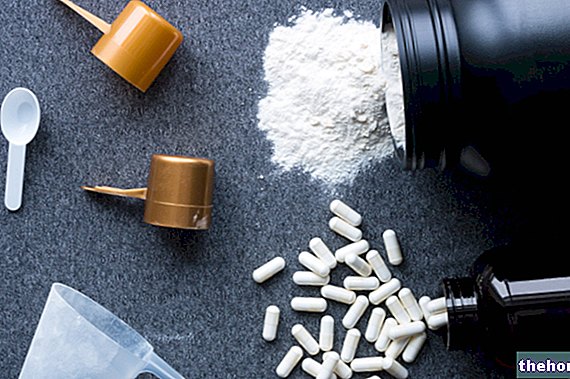Generality
Hydroxy-methyl-Butyrate, also known as HMB, is a metabolic product synthesized by the body from leucine.
Endogenous synthesis
In the cellular environment, a part of this essential amino acid (leucine) with important anti-catabolic functions undergoes a transamination reaction; the enzyme that catalyzes this reaction is called BCAT (specific transaminase for branched chain amino acids).

Most of the KIC is then converted into isovaleryl-CoA, while around 5% is metabolized into Beta-hydroxy Beta-methylButyrate (HMB); the enzyme that catalyzes this reaction is called α-ketoisocaproate dioxygenase.
Ultimately, about 60 grams of leucine are needed to synthesize three grams of HMB, which is not the case in common practice.
In fact, it is estimated that the organism of an adult man weighing 70 kg produces from 200 to 400 mg of HMB per day, obviously also depending on the dietary intake of leucine.
HMB in Foods and Supplements
Hydroxy Methyl Butyrate was discovered in pork milk; small amounts are also found in other foods, such as grapefruit, alfalfa and catfish.
Given its normal presence in food, HMB has been marketed as a patent protected supplement for some years now.
In accordance with the results of some studies, supplementation with HMB would carry out a valuable ergogenic effect, thanks to its anabolic, lipolytic and anti-catabolic properties with reduction of DOMS.
Indications
Why is HMB used? What is it for?
For several years now, anti-catabolic and immunomodulatory properties have been ascribed to HMB.
Although its anti-catabolic efficacy has been described in some critical conditions - such as adult sarcopenia, oncological cachexia or extensive trauma - the anticatabolic and anabolic effect on the healthy individual is still uncertain.
For this reason, the much publicized ability of HMB to increase muscle mass in healthy and trained subjects is yet to be clarified.
The aura of mystery surrounding HMB is probably related to the presence of contradictory studies and to a mechanism of action not yet fully understood, which would see the involvement of particularly complex muscle metabolic pathways.
Properties and Effectiveness
What benefit has HMB shown during the studies?
As mentioned, the scientific literature is somewhat debated on the real usefulness of HMB in sports.
If on the one hand HMB would seem to spare the muscle proteolysis induced by intense physical exercise, on the other hand it would not be observed an overall increase in muscle mass in healthy and training subjects (contrary to what was observed on sarcopenic and defied patients).
For this reason, the anabolic, anti-catabolic and immunomodulating activity of HMB seems to be closely related to factors such as sex, age, physical condition, muscular state and state of health.
In the health field, some studies would have highlighted the cholesterol-lowering (LDL fraction) and antihypertensive properties of HMB; still others would suggest a possible positive effect on the immune system and wound healing, while for the aforementioned stimulus on protein synthesis HMB could be of potential help in cachectic states.
In this regard, we report an "interesting and complete review of 2008, which examines all the main research conducted on HMB in recent years: Effects of beta-hydroxy-beta-methylbutyrate (HMB) on exercise performance and body composition across varying levels of age, sex, and training experience: A review - Gabriel J Wilson Jacob M Wilson Anssi H Manninen (freely available at this address).
Dosage and method of use
How to use the HMB
As regards the methods of intake, it is advisable to divide the daily intake into three single doses of one gram each or 12.5 mg per kg of body weight.
All this to compensate for the short plasma half-life of HMB, which can be quantified in two and a half hours (with return to basal levels within nine hours of intake).
Dosages greater than 3 grams per day do not seem to have significant additive effects.
HMB is generally marketed in capsules, to be swallowed with water or other beverages.
Given its ergogenic properties, it would be interesting to evaluate the additive effects of a simultaneous association between HMB and supplements with similar characteristics, such as arginine, glutamine and BCAA.
Also based on these considerations, the best times to take HMB are breakfast, the protein snack that precedes the night's rest and the one that follows training.
Side effects
There are currently no known side effects of note following the use of HMB.
This safety has also been confirmed by numerous other experimental studies conducted on animals at particularly high doses of HMB.
Contraindications
When should the HMB not be used?
The use of HMB is contraindicated in case of hypersensitivity to the active ingredient.
Pharmacological interactions
What drugs or foods can modify the effect of HMB?
There are currently no noteworthy drug interactions between HMB and other active ingredients
Precautions for use
What do you need to know before taking HMB?
Since there is no long-term research on children, nurses and pregnant women, in these moments of life HMB should not be used spontaneously, but only after a preventive medical consultation.




























